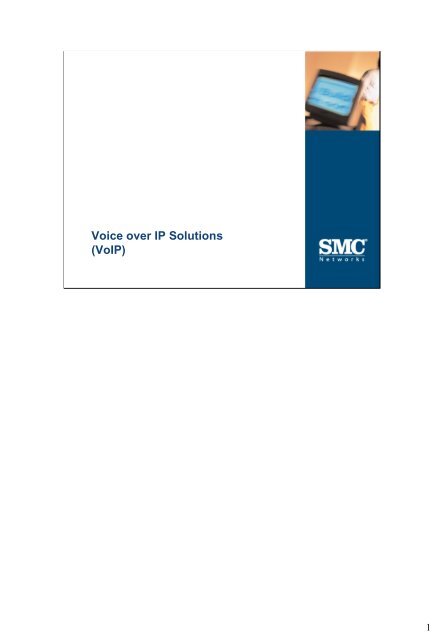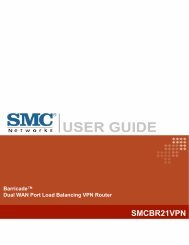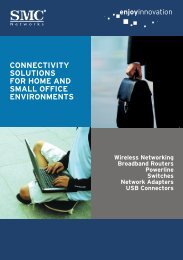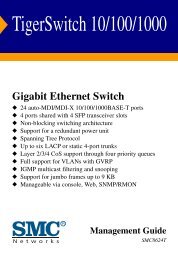Voice over IP Solutions (VoIP) - SMC
Voice over IP Solutions (VoIP) - SMC
Voice over IP Solutions (VoIP) - SMC
Create successful ePaper yourself
Turn your PDF publications into a flip-book with our unique Google optimized e-Paper software.
<strong>Voice</strong> <strong>over</strong> <strong>IP</strong> <strong>Solutions</strong><br />
(Vo<strong>IP</strong>)<br />
A-VO<strong>IP</strong>-1<br />
1
Vo<strong>IP</strong> Introduction<br />
What is Vo<strong>IP</strong>?<br />
Vo<strong>IP</strong> Device<br />
(<strong>IP</strong> Phone)<br />
<strong>Voice</strong> Call<br />
<strong>IP</strong><br />
Network<br />
Vo<strong>IP</strong> Device<br />
(PC + Vo<strong>IP</strong> Software)<br />
A-VO<strong>IP</strong>-2<br />
The fundamental idea behind <strong>Voice</strong> <strong>over</strong> <strong>IP</strong> (Vo<strong>IP</strong>) is that a phone call is<br />
sent via a series of data packets using an <strong>IP</strong> communication infrastructure.<br />
This is done to achieve a better total bandwidth utilization by allowing voice<br />
and other digital data to be “mixed” on the same <strong>IP</strong> network.<br />
The term <strong>Voice</strong> <strong>over</strong> <strong>IP</strong> is used to describe the fundamental technology,<br />
concepts and standards. The terms <strong>IP</strong> Telephony and Internet Telephony<br />
or LAN Telephony describe specific implementations of Vo<strong>IP</strong>.<br />
<strong>IP</strong> Telephony provides traditional and new advanced telephony functions<br />
<strong>over</strong> a managed or private network that can guarantee the necessary<br />
quality, predicatbility and low packet delay from one end of an network to<br />
the other. These networks are typically owned and run by a single<br />
organization like carriers and ISPs.<br />
Internet Telephony or <strong>Voice</strong> On the Net (VON) refers to an<br />
implementation of the same kind of technology using the Internet as a<br />
replacement for PSTN services. But although the Internet is a<br />
communication infrastructure based on <strong>IP</strong> it is a patchwork of many, mostly<br />
unmanaged networks, owned and operated by disparate organizations. The<br />
resulting network infrastructure therefore does not guarantee the quality,<br />
low delays and predictability necessary to provide high quality voice<br />
services. The idea of making almost cost free calls all <strong>over</strong> the Internet<br />
nevertheless has found an constantly increasing number of users all <strong>over</strong><br />
the world even if Internet telephony still lacks many of the traditional PSTN<br />
capabilities.<br />
LAN Telephony refers to technical solutions where Vo<strong>IP</strong> technology is<br />
used to replace conventional PBX technology in a high bandwidth local<br />
area network.<br />
2
Vo<strong>IP</strong> Introduction<br />
Advantages of Vo<strong>IP</strong><br />
Advantages for end users / companies:<br />
• Dramatic cost reduction for telephony<br />
• Only one communication infrastructure internally<br />
(companies)<br />
• Better scalability of the communication infrastructure<br />
• New integrated voice / video / data applications<br />
• Better and reduced management of the infrastructure<br />
• Future proof<br />
Advantages for providers and carriers:<br />
• Dramatic cost reduction (infrastructure)<br />
• New integrated and value add services<br />
• New business models<br />
A-VO<strong>IP</strong>-3<br />
There is one main motivation for implementing Vo<strong>IP</strong>: cost reduction.<br />
But it is not only about cheaper phone calls, there are many<br />
advantages for customers and providers:<br />
3
Vo<strong>IP</strong> Introduction<br />
Comparison PSTN / Vo<strong>IP</strong><br />
Communication type<br />
Communication<br />
channel<br />
Data flow<br />
Bandwidth (single call)<br />
Compression<br />
Delay<br />
Quality<br />
Error Rate<br />
Standardization<br />
PSTN<br />
channel oriented<br />
fixed path, out-of-band<br />
signaling<br />
continuous<br />
64kbps each direction<br />
no<br />
minimal, not relevant<br />
very high<br />
minimal, practically zero<br />
stable, comprehensive<br />
Vo<strong>IP</strong><br />
packet oriented, best-effort<br />
delivery<br />
virtual channel<br />
variable<br />
depends on compression<br />
algorithm used<br />
yes - various, depending on<br />
implementation<br />
significantly higher, value<br />
depends on many variables<br />
depends on many variables<br />
depends on many variables<br />
many different approaches,<br />
techn. alternatives,<br />
standardization bodies<br />
A-VO<strong>IP</strong>-4<br />
Vo<strong>IP</strong> technology is very young compared to the traditional technology<br />
behind the PSTN. Vo<strong>IP</strong> technology promises dramatic cost reduction<br />
for voice communication and is the basis for the development of new<br />
powerful services and applications. But there are also some tradeoffs<br />
when we compare the fundamental technologies. Although the<br />
PSTN infrastructure and technology is relative complex (and<br />
expensive) the PSTN delivers very reliable voice services at a very<br />
high quality with minimal delays. The technology is proven, reliable<br />
and generally accepted.<br />
It is the underlaying packet oriented networking technology that<br />
makes Vo<strong>IP</strong> the more efficient solution for voice communication. But<br />
this is also the reason for significantly higher delays, variable data<br />
flows, sometimes unpredictable network bandwidth and most of the<br />
time lower quality. This technology approach is very flexible and<br />
allows a broad range of different implementations. These range from<br />
simple Internet Telephony solutions with no guarantes for acceptable<br />
quality for the voice communication to reliable high quality <strong>IP</strong><br />
Telephony services or LAN Telephony that offer advanced and<br />
supplementary (CTI) services.<br />
4
Vo<strong>IP</strong> Introduction<br />
Vo<strong>IP</strong> Scenarios<br />
Vo<strong>IP</strong> Device<br />
<strong>IP</strong><br />
Network<br />
Telephone Gateway<br />
Telephone<br />
PSTN<br />
PSTN<br />
Gateway<br />
<strong>IP</strong><br />
Network<br />
<strong>IP</strong><br />
Network<br />
Gateway<br />
Vo<strong>IP</strong> Device<br />
Vo<strong>IP</strong> Device<br />
PSTN<br />
Telephone<br />
A-VO<strong>IP</strong>-5<br />
There are three fundamentally different Vo<strong>IP</strong> scenarios when looking at typical<br />
telephony usage:<br />
- Vo<strong>IP</strong> device to Vo<strong>IP</strong> device<br />
- Vo<strong>IP</strong> device to telephone<br />
- Telephone to telephone<br />
The scenaro “Vo<strong>IP</strong> device to Vo<strong>IP</strong> device” is referring to applications that are<br />
only using an <strong>IP</strong> network as means to interconnect the end devices. These are<br />
computers of some kind. Classic Internet Telephony and also enterprise LAN<br />
Telephony are typical examples for this scenario.<br />
In many instances it will be necessary to establish communication with end<br />
users (devices) that are not connected to the <strong>IP</strong> network but to are conventional<br />
telephone (or other devce) connected within a PSTN. In this “Vo<strong>IP</strong> to<br />
telephone” scenario the two very different communication infrastructures (<strong>IP</strong><br />
network vs. PSTN) have to be interconnected to allow calls to pass from one<br />
side to the other. The devices used to connect these fundamentally different<br />
working networks are called (interconnection) gateways.<br />
A third Vo<strong>IP</strong> communication scenario whch we best describe as “telephone to<br />
telephone” is becoming more and more important although, in most cases<br />
invisible (transparentely deployed by the voice carier) to the users. In this<br />
scenario a “communication channel” is established between conventional<br />
access infrastructures for analogue or ISDN telephones (or other devices) using<br />
an <strong>IP</strong> network infrastructure to typically to reduce cost for long distance calls.<br />
5
Building Blocks and Elements<br />
Overview<br />
Vo<strong>IP</strong> Endpoint A<br />
<strong>IP</strong> Network<br />
“Virtual<br />
Switch”<br />
Router<br />
Interconnection<br />
Gateway<br />
E1<br />
Vo<strong>IP</strong> Endpoint B<br />
SS7<br />
(Signaling)<br />
PSTN / GSTN<br />
Central<br />
Office<br />
Telephone<br />
A-VO<strong>IP</strong>-6<br />
To describe the Vo<strong>IP</strong> environment it is best to identify first the<br />
fundamental elements or building blocks, to be able to understand their<br />
principal structure and functions.<br />
The above picture shows on the left side a typical <strong>IP</strong> based network<br />
used for Vo<strong>IP</strong> applications. It can be basically any kind of <strong>IP</strong> network<br />
offering acceptable performance and reliability. On the user side Vo<strong>IP</strong><br />
endpoints (such as <strong>IP</strong> telephones or PCs) are attached to the network<br />
and can be used for voice, video and other communication applications.<br />
Special devices (switches, software PBXes, etc.) are used to provide<br />
call control and other important functions in the network.<br />
Several application scenarios require communication between Vo<strong>IP</strong><br />
users/devices and the users/devices connected to traditional PSTN<br />
infrastructures. A PSTN works fundamentally in a different way to an <strong>IP</strong><br />
networks when it comes to establishing and providing communication<br />
channels for communication endpoints. Because of this it is necessary<br />
to implement (interconnection) gateway systems that convert<br />
signalling and data formats and therefore can “bridge” between the<br />
fundamentally different communication infrstructures.<br />
6
Building Blocks and Elements<br />
PSTN / GSTN Overview<br />
Telephone<br />
PSTN<br />
(TDM)<br />
SS7<br />
E.164 Addressing<br />
(Telephone Numbers)<br />
Central<br />
Office<br />
(Switch)<br />
Enterprise Telephone System<br />
Telephone<br />
PBX<br />
Telephones<br />
A-VO<strong>IP</strong>-7<br />
PSTN (public switched telephone network) is the worlds collection of<br />
interconnected voice oriented public telephone networks that are often also referred<br />
to as the Plain Old Telephone Service (POTS). Today, these networks are almost<br />
entirely digital in technology. The final link from the central (or local) telephone<br />
office to the user (subscriber) can be digital (ISDN) but in the majority of cases still<br />
analogue. End devices connected to the PSTN have to comply to the technology<br />
used on this final link to the user.<br />
Although the PSTN today is typically digital it is by no means packet oriented(like <strong>IP</strong><br />
networks are). From a communication technology point of view the PSTN is based<br />
on TDM (Time Division Multiplexing) a type of multiplexing technology. TDM<br />
repeatedly transmits a fixed sequence of time slots <strong>over</strong> a single transmission<br />
channel and combines multiple voice or data streams by assigning each stream a<br />
different time slot in the sequence.<br />
Adressing is also different between a PSTN and an <strong>IP</strong> network. In a PSTN a<br />
telephone numbers consists of up to 15 digits, in <strong>IP</strong> networks <strong>IP</strong> addresses are<br />
used to identify individual nodes.<br />
To ensure efficient and secure worldwide telecommunications a special network<br />
and protocol named SS7 (Signaling System 7) is used in the PSTN to perform call<br />
control functions (setup, closing, etc.). It also provides enhanced call features and<br />
services (toll-free and toll services, call forwarding, local number portability, etc.)<br />
SS7 is a telecommunications protocol defined by the International<br />
Telecommunication Union (ITU) and is characterized by high-speed circuit<br />
switching and out-of-band signaling.<br />
Out-of-band signaling is signaling that does not take place <strong>over</strong> the same path as<br />
the data transfer but uses a separate digital channel (signaling link), where<br />
messages are exchanged between network elements such as telephone switches.<br />
7
Building Blocks and Elements<br />
<strong>IP</strong> Network Overview<br />
<strong>IP</strong><br />
Network<br />
Vo<strong>IP</strong> Endpoint A<br />
“Virtual Switch”<br />
Router<br />
Vo<strong>IP</strong> Endpoint B<br />
A-VO<strong>IP</strong>-8<br />
The above picture shows a typical <strong>IP</strong> based network used for Vo<strong>IP</strong><br />
applications. It can be basically any kind of <strong>IP</strong> network which offers<br />
acceptable performance and reliability.<br />
Depending on the requirements and expectations of the users these <strong>IP</strong><br />
networks can be either a managed or private MAN/WAN (<strong>IP</strong><br />
Telephony), a companies internal network (LAN/WAN) or the<br />
worldwide Internet (Internet Telephony, VOI).<br />
Addressing is based on <strong>IP</strong> addresses. This makes it necessary to<br />
provide special directory services to translate names (for example email<br />
addresses) or “real” assigned telephone numbers to the <strong>IP</strong><br />
addresses, which are used to identify an individual Vo<strong>IP</strong> endpoint.<br />
On the user side Vo<strong>IP</strong> endpoints like <strong>IP</strong> telephones or PCs with Vo<strong>IP</strong><br />
communicateion software and hardware (for example softphones) are<br />
attached to this infrastructure. They can be used for voice, video and<br />
other communication applications. Special intelligent devices (switches,<br />
software PBXes, etc.) are used to provide call control and other<br />
important functions in the network.<br />
Due to the fact that there are different ways to implement a Vo<strong>IP</strong><br />
network, names and functions of individual devices in the network differ.<br />
The two predominant technology alternatives are either based around<br />
H.323 or S<strong>IP</strong> standards (recommendations, RFCs, etc.).<br />
8
Building Blocks and Elements<br />
Vo<strong>IP</strong> Endpoints / Devices<br />
Examples of Vo<strong>IP</strong> endpoints / devices for users:<br />
• PC with Vo<strong>IP</strong> hardware and software (soft client)<br />
• PC with headset, handset, etc.<br />
• Laptop with sound system and microphone<br />
• <strong>IP</strong> telephones<br />
• VoWLAN phones<br />
• Vo<strong>IP</strong> adapter (to connect analogue phones, etc.)<br />
• Vo<strong>IP</strong> PBX (Private Branch Exchange)<br />
• IAD with integrated Vo<strong>IP</strong> gateway (Barricade)<br />
• CPEs<br />
• …<br />
Examples for Vo<strong>IP</strong> endpoints that provide additional services:<br />
• Vo<strong>IP</strong> gateways<br />
• Media server<br />
• Proxies<br />
• …<br />
A-VO<strong>IP</strong>-9<br />
A broad range of Vo<strong>IP</strong> products are today available not only as Vo<strong>IP</strong><br />
endpoints (or devices) for the user that wishes to communicate via<br />
Vo<strong>IP</strong>. Also there are systems that provide an increasing number of<br />
advanced communication services to the users:<br />
Examples of Vo<strong>IP</strong> endpoints / devices for users:<br />
• PC with Vo<strong>IP</strong> hardware and software (soft client)<br />
• PC with headset, handset, etc.<br />
• Laptop with sound system and microphone<br />
• <strong>IP</strong> telephones<br />
• VoWLAN phones<br />
• Vo<strong>IP</strong> adapter (to connect analogue phones, etc.)<br />
• Vo<strong>IP</strong> PBX (Private Branch Exchange)<br />
• IAD with integrated Vo<strong>IP</strong> gateway (Barricade)<br />
• CPEs<br />
• …<br />
Examples for Vo<strong>IP</strong> endpoints that provide additional services:<br />
• Vo<strong>IP</strong> gateways (interconnection between TDM and Vo<strong>IP</strong> networks)<br />
• Media server (voice mail, interactive voice response applications,<br />
network announcements)<br />
• Proxies (interconnection between private and public <strong>IP</strong> networks)<br />
• …<br />
9
Building Blocks and Elements<br />
Interconnection Gateways<br />
<strong>IP</strong><br />
Network<br />
Softswitch<br />
Router<br />
Vo<strong>IP</strong> Endpoint<br />
Interconnection<br />
Gateway<br />
E1<br />
SS7<br />
(Signaling)<br />
PSTN / GSTN<br />
(TDM)<br />
Central<br />
Office<br />
Analogue or ISDN<br />
Telephone<br />
A-VO<strong>IP</strong>-10<br />
(Interconnection) gateway systems convert signalling and/or data<br />
formats and therefore can “bridge” between fundamentally different<br />
communication infrastructures.<br />
Typical examples for such gateways are:<br />
• H.323-to-SS7 gateway<br />
• S<strong>IP</strong>-to-SS7 gateway<br />
• S<strong>IP</strong>-to-H.323 gateway<br />
Gateway functionality can also be found incorporated into other<br />
devices like Vo<strong>IP</strong> access router (IAD) or PBX solutions.<br />
10
Building Blocks and Elements<br />
Vo<strong>IP</strong> / PSTN Addressing<br />
Vo<strong>IP</strong> Endpoint A<br />
<strong>IP</strong> Network<br />
Directory Server<br />
Interconnection<br />
Gateway<br />
E1<br />
Vo<strong>IP</strong> Endpoint B<br />
SS7<br />
(Signaling)<br />
PSTN / GSTN<br />
Telephone<br />
A-VO<strong>IP</strong>-11<br />
A numbering plan is a type of numbering scheme that defines the structure and<br />
use of the telephone numbers used for intra-site, inter-site and outbound<br />
telephone calls.<br />
In the PSTN the numbering plan is clearly defined. A telephone number<br />
consists of up to 15 digits, made up of a one to three digit country code (CC),<br />
followed by the subscriber number (SN). The ITU recommendation E.164<br />
specifies the number structure and functionality/service of the numbers used for<br />
international public telecommunication. E.164 also defines all international<br />
country codes are defined.<br />
Within <strong>IP</strong> networks <strong>IP</strong> addresses are used to identify individual systems. When<br />
connected to the Internet every addressable node has to have its own unique <strong>IP</strong><br />
address. An additional level of complexity is created by the fact fact<br />
many users are<br />
conneted to the Internet through dial-up dial up services where the address is<br />
dynamically assigned. For plain Vo<strong>IP</strong> solutions techniques based on DNS or<br />
other directory services technologies are available.<br />
In most cases it will be necessary to dials out of the Vo<strong>IP</strong> network network<br />
into the PSTN<br />
and vice versa. There are solutions and services available that offer gateways to<br />
the PSTN from a Vo<strong>IP</strong> phone. By simply dialing a conventional telephone number<br />
the telephone call will be routed <strong>over</strong> the <strong>IP</strong> network to the defined gateway.<br />
Electronic Numbering (ENUM) makes it possible to dial traditional E.164 phone<br />
numbers, but be connected entirely <strong>over</strong> the Internet. This allows E.164 adresses<br />
to be used iwithin a DNS. Directory structure. ENUM allocates a specific zone<br />
(suffix) for use with E.164 numbers. Any phone number, can be then transformed<br />
into a hostname by reversing the numbers, separating them with dots and adding<br />
the suffix. DNS can then be used to look up internet addresses for Vo<strong>IP</strong><br />
telephony services.<br />
11
Vo<strong>IP</strong> Protocols<br />
Overview<br />
Vo<strong>IP</strong> Endpoint<br />
Vo<strong>IP</strong> Communication<br />
Call Control<br />
RTP<br />
• S<strong>IP</strong><br />
• H.323<br />
Vo<strong>IP</strong> Endpoint<br />
A-VO<strong>IP</strong>-12<br />
The predominant Vo<strong>IP</strong> technology alternatives today are H.323 and<br />
S<strong>IP</strong> (Session Initiation Protocol). Although fundamentally trying to solve<br />
the same problem - to deliver voice and other multimedia services <strong>over</strong><br />
<strong>IP</strong> - these two technology approaches differ in some ways.<br />
H.323 a “product” of the telecommunication industry. It is today an ITU<br />
(International Telecommunication Union) umbrella standard, defining<br />
a broad range of audio, video and data compression standards and<br />
protocols. Beeing an ITU standard the technology is sound and reliable<br />
but also very complex.<br />
S<strong>IP</strong> on the other hand was and is still being developed by the IETF. S<strong>IP</strong><br />
is a fast and simple signalling and application layer control protocolo for<br />
<strong>IP</strong> (Internet) multimedia applications and telephony. It is gaining fast in<br />
popularity and has be come a very attractive alternative to the much<br />
older and previously widely implemented H.323 technology.<br />
H.323 and S<strong>IP</strong> although designed by very different standardization<br />
bodies have nevertheless a lot in common. They differ fundamentaly in<br />
signaling / call control and management but both rely on RTP (Real-<br />
Time Transport Protocol) for transporting the voice (multimedia)<br />
information. They also share many of the fundamental technologies for<br />
digitizing analogue signals.<br />
H.323 and S<strong>IP</strong> are by no means the only protocols to build Vo<strong>IP</strong><br />
solutions. There are a broad range of technology alternatives including<br />
many proprietary solutions of individual manufacturers as well as<br />
standards like Megaco/H.248 or MGCP. MGCP (Multimedia Gateway<br />
Control Protocol) is typically used in Vo<strong>IP</strong> solutions utilizing TV cable<br />
network infrastructures.<br />
12
Signaling Protocols<br />
H.323 Introduction<br />
Signaling,<br />
Call control<br />
H.323<br />
Media transport,<br />
Payload<br />
Audio, Video<br />
Codecs<br />
RTP<br />
TCP UDP<br />
<strong>IP</strong><br />
Quality of Service<br />
RTCP RSVP<br />
A-VO<strong>IP</strong>-13<br />
H.323 is an interoperability standard that describes the modes of<br />
operation required for various audio, video, and/or data terminals to work<br />
together.It is one of the important standards for <strong>IP</strong> / Internet voice and<br />
video applications including <strong>IP</strong>/Internet phones as well as audio and<br />
video conferencing equipment.<br />
The development of H.323 originally was focussed on LAN video<br />
conferencing applications. When it was ratified in 1996 by the ITU<br />
(International Telecommunication Union) it became an umbrella<br />
standard, defining a broad range of audio, video and data compression<br />
standards and protocols.<br />
The H.323 standard specifies the following protocols and technologies:<br />
• Codecs for audio and video<br />
• Registration, admission and status (H.225)<br />
• Call signalling (H.225)<br />
• Control signalling (H.245)<br />
• RTP (Real-time Transfer Protocol)<br />
• RTCP (Real-time Control Protocol)<br />
H.323 can be implemented in various different ways. Depending on the<br />
application it can be used for audio/voice only (telephony), audio and<br />
video (video conferencing, video telephony), audio and data<br />
(whiteboaarding), or all of these applications combined (full video and<br />
data conferencing).<br />
13
Signaling Protocols<br />
H.323 Architecture<br />
V.70<br />
Terminal<br />
H.324<br />
Terminal<br />
H.323<br />
Terminal<br />
H.323<br />
MCU<br />
Speech<br />
Terminal<br />
H.323<br />
Terminal<br />
H.322<br />
Terminal<br />
H.323<br />
Terminal<br />
H.323<br />
Gateway<br />
Speech<br />
Terminal<br />
H.320<br />
Terminal<br />
H.323<br />
Terminal<br />
H.323<br />
Gatekeeper<br />
QoS<br />
PSTN N-ISDN B-ISDN<br />
LAN<br />
H.321<br />
Terminal<br />
LAN / Network<br />
H.310<br />
Terminal<br />
A-VO<strong>IP</strong>-14<br />
The architecture of H.323 contains several componente (or elements) that<br />
perfom specific functions in the network:<br />
Endpoint Terminals are used for bidirectional multimedia communications.<br />
They are either a PC or a dedicated device supporting H.323 and one or<br />
more applications (like an <strong>IP</strong> phone for example). A H.323 terminal consists<br />
of at least a network interface, a System Control Unit (SCU), the H.255<br />
Layer and an audio codec unit for voice applications. Video codecs and<br />
other user data applications are optional components. H.323 terminals are<br />
compatible with H.324 terminals on POTS, H.320 terminals on ISDN, H.310<br />
terminals on B-ISDN, H.322 terminals on guaranteed QoS LANs and V.70<br />
GSTN (Global Switched Telephone Network) terminals.<br />
H.323 Gateways are used to interconnect various different telephony (and<br />
video conferencing) technologies. These gateways convert digitized voice<br />
into <strong>IP</strong> packetand, translate call control information.<br />
H.323 Gatekeeper function as virtual PBX or switch. H.323 does not<br />
require a Gatekeeper to be implemented. If deployed it acts as the central<br />
point for switching all calls within its domain. Terminals will first contact the<br />
Gatekeeper, which then controls the calls by granting (or denying)<br />
permission for the call and by instructing endpoints about how to perform<br />
call control and other functions.<br />
Although multipoint conferencing on the H.232 network can be done in a<br />
decentralized way, often Multipoint Control Units (MCUs) or Multipoint<br />
Controllers (MCs) are used for centralized multipoint conferences. MCUs<br />
perform audio mixing and voice switching between several endpoints and<br />
coordinate the call control and codec negotiation between all participating<br />
devices.<br />
14
Signaling Protocols<br />
S<strong>IP</strong> Introduction<br />
Signaling,<br />
Call control<br />
S<strong>IP</strong><br />
Media transport,<br />
Payload<br />
Audio, Video<br />
Codecs<br />
RTP<br />
TCP UDP<br />
<strong>IP</strong><br />
Quality of Service<br />
RTCP RSVP<br />
A-VO<strong>IP</strong>-15<br />
The Sesssion Initiation Protocol (S<strong>IP</strong>) is a relatively new Internet<br />
standard that basically is a simple signaling and application layer control<br />
protocol for multimedia conferencing and telephony. It is today besides<br />
H.323 the most important standard for <strong>IP</strong> / Internet voice applications.<br />
S<strong>IP</strong> is defined in RFC 2543, as part of the MMUSIC (Multiparty<br />
Multimedia Session Control) working group of the IETF. This group is<br />
working on a complete framework of protocols to solve abroad range of<br />
multimedia conferencing and communication solutions. These include SDP<br />
(Session Description Protocol), SAP (Session Announcement Protocol),<br />
RTSP (Real-Time Stream Protocol), SCCP (Simple Conference Control<br />
Protocol) and S<strong>IP</strong>.<br />
S<strong>IP</strong> is a simple, low-level protocol for establishing, modifying or terminating<br />
multimedia sessions or Internet telephony calls between two or more users.<br />
Such sessions can include voice, video, chat, other multimedia data (such<br />
as interactive games).The protocol can also invite participants to unicast or<br />
multicast sessions.<br />
S<strong>IP</strong> supports name mapping and redirection services. This makes it<br />
possible to identify users regardless where they are and allows users to<br />
initiate and receive connections and services from any location.<br />
S<strong>IP</strong> is a simple request-response protocol, dealing with requests from<br />
clients and responses from servers. Users are identified by S<strong>IP</strong> URLs. S<strong>IP</strong><br />
determines the end system to be used for the session, the communication<br />
media and media parameters. It then initiates the communication. It<br />
establishes call parameters at each end of the communication, and handles<br />
call transfer and termination. Like H.323 S<strong>IP</strong> uses the RTP (Real-Time<br />
Transport Protocol) for transporting the voice (multimedia) information.<br />
15
Signaling Protocols<br />
S<strong>IP</strong> Architecture<br />
V.70<br />
Terminal<br />
S<strong>IP</strong><br />
Terminal<br />
Location<br />
Server<br />
H.324<br />
Terminal<br />
S<strong>IP</strong><br />
Terminal<br />
Speech<br />
Terminal<br />
S<strong>IP</strong><br />
Terminal<br />
S<strong>IP</strong><br />
Gateway<br />
PSTN N-ISDN<br />
Speech<br />
Terminal<br />
S<strong>IP</strong><br />
Server<br />
H.320<br />
Terminal<br />
S<strong>IP</strong><br />
Terminal<br />
H.321<br />
Terminal<br />
LAN / Network<br />
B-ISDN /<br />
ATM<br />
H.310<br />
Terminal<br />
A-VO<strong>IP</strong>-16<br />
The S<strong>IP</strong> architecture contains several componente (or elements) that<br />
perfom specific functions in the network:<br />
S<strong>IP</strong> Endpoint Terminals are used for bidirectional multimedia<br />
communications and are either a PC or a dedicated device<br />
supporting S<strong>IP</strong> and one or more applications (like an <strong>IP</strong> phone for<br />
example). S<strong>IP</strong> terminals are compatible with H.324 terminals on<br />
POTS, H.320 terminals on ISDN, H.310 terminals on B-ISDN, H.322<br />
terminals on guaranteed QoS LANs and V.70 GSTN (Global<br />
Switched Telephone Network) terminals.<br />
A Location Server maintain the <strong>IP</strong> addresses of all users and is, for<br />
example responsible for translating alias names to <strong>IP</strong> addresses.<br />
The S<strong>IP</strong> Server is responsible for call handling and call<br />
establishment. Call control can be implemented in one of two ways -<br />
either in proxy mode or in redirect mode.<br />
Just like H.323 Gateways, S<strong>IP</strong> Gateways are used to interconnect<br />
various different telephony (and video conferencing) technologies.<br />
These gateways convert digitized voice into <strong>IP</strong> packets and translate<br />
call control information.<br />
16
Media Transport Protocols<br />
RTP<br />
UDP Header<br />
<strong>IP</strong> Header<br />
Ethernet<br />
Protocoll<br />
Information<br />
Audio Data<br />
RTP Header<br />
ETH<br />
<strong>IP</strong><br />
UDP<br />
RTP<br />
Bits<br />
Data<br />
Application<br />
Host-to-Host<br />
Internet<br />
Network Protocols<br />
Hardware<br />
Structure of an Ethernet RTP Packet TCP/<strong>IP</strong> Architecture<br />
RTP (Real-time Transport Protocol) in conjunction with RTCP<br />
(Real-Time Transport Control Protocol) has been used by the<br />
research and university community for years on the Mbone. This<br />
network is the Internet's still somewhat experimental multicast<br />
backbone, for video conferencing and telephony <strong>over</strong> <strong>IP</strong>. It never<br />
gained general acceptance because of its very limited signalling<br />
capabilities.<br />
A-VO<strong>IP</strong>-17<br />
The (RTP) was specifically designed to allow the transport of<br />
isochrounous data across a packet network. It addresses some of the<br />
problems occuring in such networks such as jitter and desequenced<br />
packets. Typically it is used in combination with UDP. On top of UD,P<br />
it can be sent in multicast <strong>IP</strong> packets, which means that a RTP<br />
stream originating from a single source node can be simultaneously<br />
sent to multiple destination nodes.<br />
17
Codecs<br />
Introduction<br />
Analogue Signal Sampled and quantisized<br />
analogue Signal<br />
A-VO<strong>IP</strong>-18<br />
In order to be transmitted across computer networks voice (the same is<br />
true in principle for video) has to be converted from its analogue form into<br />
a digital format. This digitizing of data is done by discretizing the signal in<br />
time (sampling) and then discretizing the signal in amplitude.<br />
The systems that perform this conversion process (in both directions) are<br />
called codecs. In adition to the actual digitalization of analogue signals<br />
these codecs further processes the data to further reduce the amount of<br />
data further and to optimize it for the transmission. Parameters like the<br />
sampling rate, the number of bits used to encode the data and the<br />
methods used to optimize the transmission greatly influence the quality of<br />
the digitized speech.<br />
Vo<strong>IP</strong> systems may have several different codecs implemented. This<br />
means that negotiating and agreeing on the codec actually used is part of<br />
any Vo<strong>IP</strong> communication.<br />
Typical examples of codes are<br />
• G.711 PCM<br />
• G.723.1 MP-MLQ<br />
• G.729 CS-ACELP<br />
• G.726 ADPCM<br />
• G.723 MP-MLQ<br />
• G,728 LD-CELP<br />
18
Quality of Service<br />
Introduction<br />
To transmit voice with an apropriate quality several requirements<br />
have to be met:<br />
• Enough bandwidth has to be provided reliably and any time<br />
• Delay has to be kept constantly below a certain level<br />
• Changes in the delay (jitter) have to be kept to a minimum<br />
• Good voice codecs (appropriate to the avail. bandwidth)<br />
• Echo cancellation<br />
• Miminal or no packet loss<br />
A-VO<strong>IP</strong>-19<br />
When it comes to quality expectations for telephony applications, the<br />
digital PSTN of today sets a very high standard. Short delays, a clear<br />
signal and high reliability is what we expect of our daily used telephone<br />
services. Although Vo<strong>IP</strong> solutions have the potential to deliver<br />
comparable communication quality in theory, the actual quality we get<br />
depends on many differrent factors.<br />
To improve the communication quality in packet oriented networks many<br />
technical solutions are either already available or under development.<br />
QoS technologies play an increasing role in improving the acceptance of<br />
Vo<strong>IP</strong>.<br />
“Qualty of Service” (QoS) might be best defined as the ability of a<br />
(communication) system or network to guarantee specific<br />
parameters or values when it comes to uptime, throughput, delays,<br />
error rate, etc.<br />
The term QoS as used in the context of <strong>IP</strong> networks and Vo<strong>IP</strong> refers to a<br />
broad collection of networking protocols, technologies and techniques<br />
that provide and control buffering, voice packet priorization, echo<br />
cancellation and guaranteed bandwidth.<br />
19
Quality of Service<br />
Layer 2/3 Networking Technologies<br />
QoS solutions can be roughly divided into the following groups:<br />
• WAN/MAN technologies with QoS capabilities<br />
• Layer 2 switching technologies<br />
• Layer 3 switching and routing protocols and technologies<br />
• Internet / <strong>IP</strong> QoS protocols<br />
• Rate control solutions<br />
A-VO<strong>IP</strong>-20<br />
QoS can be implemented at very different levels in the network. <strong>Solutions</strong><br />
largely depend on the underlaying network technology and structure.<br />
WAN MAN protocols and technologies used by carriers and other providers of<br />
WAN/MAN services quite often have comprehensive QoS functionality built in.<br />
Typical examples of such technologies are ATM (Asynchronous Transfer<br />
Mode, SONET (Synchronous Optical Network) and Frame Relay.<br />
Layer 2 as well as Layer 3 switching technology is available today to deliver<br />
QoS functionality in typical enterprise, but also some carrier networking<br />
infrastructures. These technologies range from simple CoS (Class of Service)<br />
implementations in LAN switches (different priority queues) to sophisticated<br />
layer 2/3 switching solutions. Typical examples for such QoS switching<br />
solutions are either prorietary approaches like <strong>IP</strong> Switching or Tag Switching or<br />
standards based technologies such as MPLS (Multiprotocol Label<br />
Switching).<br />
Of special interest for Vo<strong>IP</strong> solutions in general are technologies and protocols<br />
providing Layer 3 QoS solutions that allow the limitations and problems in (also<br />
large) <strong>IP</strong> network including the Internet to be <strong>over</strong>come. Typical examples for<br />
such QoS solutions or approaches are RTCP (Real-Time Transport Control<br />
Protocol), RSVP (Resource ReServation Protocol) and RTSP (Resource<br />
Reservation Protocol).<br />
In order to be able to solve some QoS problems at specific bottlenecks in the<br />
network infrastructure, special rate control solutions have been developed.<br />
These bandwith management and traffic shaping solutions typically work<br />
transparently and allow the priorization, reservation, limitation and blocking of<br />
<strong>IP</strong> communication at an application/protocol and/or network/host level.<br />
20
Quality of Service<br />
Internet / <strong>IP</strong> QoS Protocols<br />
Signaling,<br />
Call control<br />
S<strong>IP</strong> H.323<br />
TCP<br />
Media transport,<br />
Payload<br />
Audio, Video<br />
Codecs<br />
RTP<br />
Quality of Service<br />
RTCP RSVP<br />
A-VO<strong>IP</strong>-21<br />
Before multimedia and Vo<strong>IP</strong> applications can be widely used, the <strong>IP</strong><br />
networks must be modified to support real-time QoS and provide<br />
controlled end to end delays. This is especially true for the Internet<br />
infrastructure.<br />
<strong>IP</strong><br />
In typical Vo<strong>IP</strong> communications RTP (Real-Time Transport<br />
Protocol) will be used for transporting the actual voice (multimedia)<br />
information. Because RTP does not provide the QoS functionality<br />
needed various protocols have been developed or are under<br />
development. These offer additional levels of control and better QoS<br />
for RTP communications in <strong>IP</strong> networks and the Internet.<br />
RTCP (Real-Time Transport Control Protocol) is a protocol to<br />
exchange control information from time to time bewteen the<br />
participants of a particular RTP session. RTCP control packets can<br />
include information about the mapping of participants to specific<br />
single stream sources and about the quality of the transmission in the<br />
network.<br />
The Resource ReServation Protocol (RSVP), is an Internet control<br />
protocol specially designed to enable applications to request a<br />
specific quality of service from the network. It is used by both network<br />
hosts and routers. RSVP treats an application flow as a one-way<br />
connection sending QoS request from the sender to the receiver.<br />
RSVP is a transport layer protocol that uses <strong>IP</strong> as its network layer<br />
and is designed to operate with other unicast and multicast routing<br />
protocols.<br />
UDP<br />
21
Security<br />
Overview<br />
Vo<strong>IP</strong> Endpoint<br />
Vo<strong>IP</strong> Endpoint<br />
Gateway /<br />
Vo<strong>IP</strong> PBX<br />
Vo<strong>IP</strong> Endpoint<br />
Internet /<br />
<strong>IP</strong> Network Vo<strong>IP</strong><br />
Endpoint<br />
Firewall /<br />
VPN Gateway<br />
A-VO<strong>IP</strong>-22<br />
The fast deployment of Vo<strong>IP</strong> solutions not only offers new possibilities<br />
and opportunities but also introduces new risks. The fundamental<br />
technology changes for voice communication introduce new threats and<br />
new challenges for security specialists and network administrators.<br />
Eavesdropping on conversations in the network by intercepting a Vo<strong>IP</strong><br />
connection is only one example of the new security threats. However,<br />
security measures in general to not differ very much from networks<br />
without Vo<strong>IP</strong>. Whether the goal of the attacker is to gain information,<br />
steal resources or to disrupt business processes, the used approaches<br />
and tools are pretty much the same.<br />
But there are certainly security issues to be adressed that result from the<br />
specific Vo<strong>IP</strong> technology implemented. The S<strong>IP</strong>standard for example<br />
does include functions to enhance media security (encryption), message<br />
exchange security and authentication. Also in H.323 there are functions<br />
and protocols (described in H.235) that are designed to provide better<br />
levels of authentication, privacy and integrity.<br />
In situations where higher levels of privacy and security are needed,<br />
technologies like firewalls, authentification systems and VPN<br />
technology can be implemented.<br />
Some of the “classic” attack patterns or techniques like DDoS attacks,<br />
will probably also be directed at Vo<strong>IP</strong> servers and gateways. Firewall<br />
systems need to be configured or even upgraded to be able to prevent<br />
damage to the network and its components.<br />
22
Security<br />
Vo<strong>IP</strong> and Firewalls / NAT<br />
Internet<br />
Public<br />
Network<br />
RTP /<br />
RTCP<br />
Router<br />
Either access router<br />
or firewall performs<br />
network address<br />
translation (NAT)<br />
Firewall<br />
Private Network<br />
A-VO<strong>IP</strong>-23<br />
Although not a security problem, special attention has to be given to<br />
communication issues and problems . In particular, those that have to do<br />
with techniques (mainly network address translation) used in many<br />
firewall solutions and IADs (Internet Access Devices) - such as access<br />
routers.<br />
NAT (Network Address Translation) techniques allow more than one<br />
system (for example a LAN) to be connect to the Internet using a single<br />
(often even dynamically assigned) <strong>IP</strong> address. The address translation<br />
device converts the outgoing <strong>IP</strong> address of each LAN device into its<br />
single Internet address and vice versa. Because of serious limitations<br />
related to incoming connections that cannot be simply directed to the<br />
individual systems in the internal network, these network address<br />
translation devices need special software that work at an<br />
application/protocol level (for example S<strong>IP</strong> signaling proxies and H.323<br />
proxies) to <strong>over</strong>come these issues.<br />
Other issues or problems that have to be taken into account when using<br />
systems like firewalls or VPN gateways in Vo<strong>IP</strong> solutions have to do with<br />
the additional latency that these systems would cause. This means that<br />
a lot of attention has to be given to the <strong>over</strong>all network design and the<br />
selection of network and security devices that are in the communication<br />
path between Vo<strong>IP</strong> systems to keep latency at a minimum.<br />
?<br />
23
Vo<strong>IP</strong> Scenarios<br />
Introduction<br />
Telephone<br />
PSTN<br />
Gateway<br />
Off-Net Call<br />
Vo<strong>IP</strong><br />
Endpoint<br />
<strong>IP</strong><br />
Network<br />
On-Net Call<br />
Vo<strong>IP</strong><br />
Endpoint<br />
A-VO<strong>IP</strong>-24<br />
Vo<strong>IP</strong> can be deployed and implemented in many different ways and<br />
application scenarios. The complexity of Vo<strong>IP</strong> results to some degree<br />
from the fact that several different Vo<strong>IP</strong> technologies, standards and<br />
implementations are often combined.<br />
The terms on-net and off-net for example refer to two different levels of<br />
complexity in Vo<strong>IP</strong> communications. An on-net call originates and<br />
terminates within a single enterprises or providers network. Off-net<br />
calls on the other hand cross the bounbdaries of the providers<br />
respectively enterprise network and require therefore special technology<br />
(gateways, etc.) and have other compatibility aspects (signaling, coding,<br />
etc.) taken into account.<br />
A good way of simplifying the subject further is to look at specific<br />
application scenarios or implementations. Typical Vo<strong>IP</strong> scenarios or<br />
applications are for example :<br />
• Residential user / branch office with ITSP<br />
• (On-net) Internet Telephony solutions<br />
• Long distance call services (PSTN to PSTN)<br />
• LAN Telephony / small PBX replacement<br />
• WLAN hotspot with ITSP<br />
• Vo<strong>IP</strong> Access Router / IAD for SME networks<br />
24
Vo<strong>IP</strong> Scenarios<br />
Internet Telephone Services<br />
Vo<strong>IP</strong> Endpoint<br />
Softswitch<br />
<strong>IP</strong> Network<br />
Router<br />
Gateway /<br />
Vo<strong>IP</strong> PBX<br />
Vo<strong>IP</strong> Endpoint<br />
Interconnection<br />
Gateway<br />
Vo<strong>IP</strong> Endpoint<br />
PSTN<br />
Central<br />
Office<br />
Analogue or ISDN<br />
Telephone<br />
A-VO<strong>IP</strong>-25<br />
An ITSP (Internet Telephony Service Provider) interconnects the<br />
PSTN with the Internet by implementing interconnection gateways.<br />
Residential users as well as enterprise users can make very cheap<br />
(sometimes cost free) on-net calls within the provider <strong>IP</strong> network, or the<br />
Internet.<br />
Most ITSPs offer telephony services that allow their users/subscribers<br />
to establish telephone communications also with subscribers that are<br />
connected to the PSTN (off-net calls) at comparatively low charges.<br />
Most ITSPs therefore assign a normal telephone number to their<br />
customers. Every call that is made from the PSTN to that number will be<br />
routed by the interconnection gateway to the customer’s <strong>IP</strong> phone.<br />
The same technology approach is the basis for special long distance<br />
call service offerings where an <strong>IP</strong> network infrastructure is used to<br />
interconnect two PSTN users/subscribers. Extreme cost reduction for<br />
long distance services/calls are possible in these cases .<br />
25
Vo<strong>IP</strong> Scenarios<br />
LAN Telephony<br />
Vo<strong>IP</strong> Endpoint<br />
Vo<strong>IP</strong> Endpoint<br />
Gateway /<br />
Vo<strong>IP</strong> PBX<br />
Vo<strong>IP</strong> Endpoint<br />
Telephone<br />
PSTN<br />
Gateway<br />
Vo<strong>IP</strong> Endpoint<br />
Vo<strong>IP</strong> Endpoint<br />
Vo<strong>IP</strong><br />
Endpoint<br />
<strong>IP</strong><br />
Network<br />
Gateway /<br />
Vo<strong>IP</strong> PBX<br />
Vo<strong>IP</strong> Endpoint<br />
A-VO<strong>IP</strong>-26<br />
LAN Telephony refers to Vo<strong>IP</strong> solutions that are designed to replace<br />
conventional PBX technology in both the small office or enterprize<br />
environment.<br />
LAN Telephony is today a well accepted technology. This is mainly because<br />
of its easy implementation and management and the dramatic cost reduction<br />
by not having to implement an expensive completely separate communication<br />
for telephony solutions next to the data network.<br />
But cost reduction is only one good reason for LAN Telephony. This<br />
technology allows much faster implementation of new and advanced<br />
communication applications (CTI, whiteboarding, etc.) and plays in many<br />
businesses an important role in increasing competitiveness and efficiency.<br />
Many problems and difficulties that only have been partly solved in large <strong>IP</strong><br />
WAN infrastructures and the Internet can be ignored in todays switched high<br />
bandwidth local area networks. There are hardly any constrains when it<br />
comes to delay, network error rate or bandwidth in a well designed switches<br />
Ethernet LAN.<br />
The actual technical implementation will depend on the choosen Vo<strong>IP</strong><br />
technology. S<strong>IP</strong> and H.323 solutions for example differ in architecture and<br />
setup.<br />
LAN Telephony solutions not necessarily have to be connected to the Internet<br />
or an <strong>IP</strong> network. In many cases the Vo<strong>IP</strong> PBX systems are connected to the<br />
PSTN - exactly the same way as conventional PBX systems are. Often the<br />
Vo<strong>IP</strong> PBX is connected to both, the PSTN and an <strong>IP</strong> network (Internet). In<br />
this cases the user is able to benefit from the low costs of Internet or <strong>IP</strong><br />
Telephony solutions but still can leverage the specific benefits that PSTN<br />
technology offers (availability, special services, etc.).<br />
26
Vo<strong>IP</strong> Scenarios<br />
Vo<strong>IP</strong> IAD / Access Router (for SMEs)<br />
Telephone<br />
PSTN<br />
Vo<strong>IP</strong> Endpoint<br />
Vo<strong>IP</strong> Endpoint<br />
Gateway<br />
Access<br />
Router<br />
Vo<strong>IP</strong> Endpoint<br />
<strong>IP</strong><br />
Network<br />
Telephone<br />
(Analogue)<br />
Vo<strong>IP</strong><br />
Endpoint<br />
A-VO<strong>IP</strong>-27<br />
For SME customers and smaller offices the perfect Vo<strong>IP</strong> solution<br />
consitst of an IAD (internet access device) or access router with<br />
integrated Vo<strong>IP</strong> gateway functionality.<br />
Good devices offer all the <strong>IP</strong> routing, NAT, security and management<br />
functions to provide Internet access for one or more computer systems<br />
in the local network. Additional QoS features and the necessary server<br />
and gateway functions allow the customer to quickly configure a<br />
complete Vo<strong>IP</strong> (LAN Telephony, <strong>IP</strong> Telephony, Internet Telephony)<br />
solution. These Vo<strong>IP</strong> IADs will support one or several of the Vo<strong>IP</strong><br />
standards (H.323, S<strong>IP</strong>, MGCP, etc).<br />
Some of these devices will support an additional ISDN or analogue<br />
PSTN telephone connection. This allows the user to alternatively use<br />
this connection in case of a problem with the Internet connection or to<br />
use special voice services that are not available from within the Vo<strong>IP</strong><br />
network. The user can define in a dialing plan which numbers should be<br />
routed into either the PSTN or the Vo<strong>IP</strong> (Internet, etc.) network<br />
For users that wish to use existing analogue devices (telephones, DECT<br />
wireless phones, fax machines, etc) in their Vo<strong>IP</strong> solution, some access<br />
devices have integrated Vo<strong>IP</strong> adapters that provide one (or more)<br />
analogue ports.<br />
.<br />
27

















